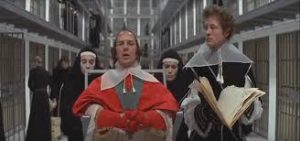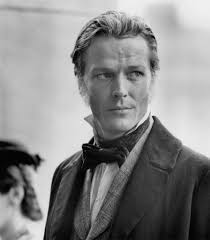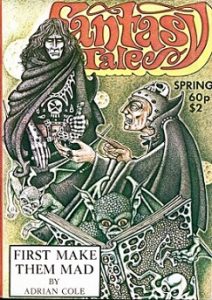
© Russo Productions / Warner Bros.
A few days ago, Murray Melvin – the much-loved British theatrical actor, director and archivist, and a performer too on TV and in film – died at the age of 90. While the stage was evidently Melvin’s first love, I remember him mainly for turning up in a lot of admirable, or at least memorably oddball, films: Tony Richardson’s A Taste of Honey (1961), Lewis Gilbert’s Alfie (1966), Desmond Davis’s Smashing Time (1967), Stephen Weeks’s Ghost Story (1974) and Stanley Kubrick’s Barry Lyndon (1975).
Melvin also appeared in four films directed by that wonderful ‘enfant terrible’ of 1960-70s British cinema, Ken Russell: The Devils, The Boy Friend (both 1971), Lisztomania (1975) and Prisoner of Honour (1991), plus in various items of Russell’s television work. And he was in a half-dozen films directed by the equally-noteworthy Peter Medak: A Day in the Death of Joe Egg (1972), Ghost in the Noonday Sun (1974), The Krays (1990), Let Him Have It (1991), David Copperfield (2000) and The Ghost of Peter Sellers (2018). That last film was a documentary about the making of Ghost in the Noonday Sun and Medak’s own meditation on why the film was such a disaster, why it never got released by the studio, and why it nearly put an end to his filmmaking career. (The answer to all those questions is in the documentary’s title.) Melvin popped up to tell a few anecdotes from his time on Noonday Sun, still as bright as a button even though by then he was well into this eighties.
As a little tribute to Melvin, here’s a reposting of something I wrote back in 2019 about a film that features one of his best performances – Ken Russell’s gloriously provocative The Devils.
I wrote the following piece after watching a 111-minute version of The Devils – the ultra-controversial 1971 film starring Oliver Reed and directed by Reed’s friend, and some would say partner-in-crime, Ken Russell – on a DVD put out by the British Film Institute and introduced by Mark Kermode. However, I understand that a longer version of the film, with an extra six minutes of restored footage, has been available since 2004.
If you haven’t seen The Devils in any of its versions, don’t read on. There will be spoilers galore.
Based on historical events in 17th century France, and on two works inspired by those events, Aldous Huxley’s book The Devils of Loudon (1952) and John Whiting’s play The Devils (1961), the film deals with skulduggery at national and local levels. The power-hungry Cardinal Richelieu (played by Christopher Logue, who was best known as a poet) encourages Louis XIII (Graham Armitage) to create a centralised and authoritarian France, with the Catholic Church entrenched as keeper of the national faith. This means taking action against those French cities where power has become so entrenched that they function like autonomous city-states.

© Russo Productions / Warner Bros.
Particularly irksome to Richelieu is the city of Loudon, which has kept its independence thanks to its huge fortified city walls and which has a dismaying tendency to treat its Protestant citizens as equals of the Catholic ones. Richelieu sends his agent, Baron Jean de Laubardemont (Dudley Sutton), with orders to demolish Loudon’s walls and bring the city to heel. However, de Laubardemont is thwarted when confronted by Urbain Grandier (Reed), an eloquent and powerful city priest who’s able to bring the citizenry onto the streets to resist him and his soldiers.
Grandier’s political principles might be high-minded but his personal ones are anything but. A philanderer and predator, he’s already impregnated and abandoned one woman (Georgina Hale) and is busy wooing another (Gemma Jones), whom he marries in a secret ceremony after claiming to have found theological justification that priests can become husbands.
Meanwhile, de Laubardemont joins forces with members of the local clergy, judiciary and trades whom Grandier has offended for personal or professional reasons and they conspire to destroy him. Their means of doing so comes from an unexpected source – the scoliosis-stricken Sister Jeanne des Anges (Vanessa Redgrave), abbess of a Loudon convent. Although she’s never met Grandier, Sister Jeanne has worshipped him from afar, first in a spiritual way and then – through a series of increasingly perverse and graphic visions – in an ungodly, sensual one. Eventually she becomes deranged, her hysteria infects the nuns under her governance, and she accuses Grandier of using witchcraft to possess and corrupt her and her convent. De Laudardemont and his allies promptly summon the witch-hunting Father Barre (Michael Gothard) to investigate. When they’ve gathered enough ‘evidence’, they have Grandier charged with witchcraft and put him on trial for his life.

© Russo Productions / Warner Bros.
With its mixture of politics, sex, violence and religion, which Russell respectively depicts cynically, explicitly, unflinchingly and sacrilegiously, The Devils was and still is a provocative watch. It had an ‘X’ certificate slapped on it in the USA, which meant few Americans got to see it. X-certificate movies were assumed to be pornographic ones and got few theatre-bookings. In addition, both the studio, Warner Brothers, and the censors took scissors to its more inflammatory scenes. And Britain’s establishment critics were aghast. The prissy and grumpy Leslie Halliwell, whose Filmgoers’ Companion books were for many years the only film-reference books British people read, dismissed it as ‘outrageously sick’ and ‘in howling bad taste from beginning to end’, while the hostility shown by the Evening Standard’s Alexander Walker culminated in a bust-up in a TV studio where Russell smacked the critic over the head with a rolled-up copy of his own newspaper.
These days, predictably, all that condemnatory water has passed well under the bridge. Younger critics and filmmakers recognise Russell as a flamboyant auteur who added welcome dashes of flair, colour, imagination and daringness to a British film industry that was long accustomed to making stodgy historical costume dramas and dreary kitchen-sink dramas and seemed unaware that cinema is supposed to be, you know, cinematic. And The Devils is acknowledged as his masterpiece. For instance, Ben Wheatley, director of Kill List (2011) and High Rise (2016), has said, “The Devils to me stands alone in Ken Russell’s work. It has all the fierceness and craziness of his movies, but it also has a seriousness and an intensity that isn’t in his other movies.”
Anyway, what’s my assessment The Devils? Well, I’ll start with what I regard as the movie’s weakness. Although it’s intended to be over the top, it goes a bit too over the top during the lengthy sequences where Father Barre and his lackeys invade the convent searching for proof of Grandier’s demonic influence. Barre has already, secretly, threatened the nuns with execution unless they agree to behave hysterically. And on cue, those nuns put on a hell of a show – a chaotic fracas of nudity, licentiousness, writhing, screaming, eye-goggling, tongue-waggling, attempted copulation with candlesticks and lewd carry-on with a giant effigy of Christ on the cross. At this point, you feel you’re watching not so much a Ken Russell film as a parody of a Ken Russell film. Which come to think of it, was what his later Lair of the White Worm (1988) was.

© Russo Productions / Warner Bros.
Otherwise, I think The Devils is magnificent. Its highlights include the stylised sets by a young Derek Jarman, which eschew the grime, grubbiness and gloom you associate with life four centuries ago and instead are dazzlingly white and clean, but also disturbingly clinical. These include Sister’s Jeanne’s convent, whose warren of chambers and passageways have the look of some germ-free medical institution – presumably one for the insane – and Richelieu’s headquarters, which resemble a cross between a giant bank-vault and a well-scrubbed prison and are disconcertingly staffed by priests and nuns. The Devils’ policy of telling a historical story but not with historically accurate backdrops would appear in later British movies, most notably those made by Jarman himself when he became a director, such as Caravaggio (1986) and Edward II (1991). And I suspect that an also-young Peter Greenaway was making notes, because The Devils has sequences reminiscent of his films, for example, one where Russell’s camera closes in on the still figure of de Laubardemont while he stands against a painting-like tableau.
The performances are another highlight. The band of conspirators set on eliminating Grandier are played by a splendid rogue’s gallery of British character actors. Dudley Sutton makes a credibly villainous de Laubardemont, his rottenness tempered with a soldierly practicality and matter-of-factness. Northern Irish actor Max Adrian and British sitcom stalwart Brian Murphy – yes, that’s George from George and Mildred (1976-80) – are fabulously contemptible as the pair of quack medical practitioners who fall out with Grandier when he catches them trying to treat a plague victim with glass globes containing bees placed over the buboes and, even more bizarrely, a stuffed crocodile. “What fresh lunacy is this?” Grandier bellows at them, a line that became the title of Robert Sellers’ biography of Oliver Reed, published in 2013.
There are excellent turns too from the impish Georgina Hale, embittered but endearing as the woman Grandier has wronged, and John Woodvine – Doctor Hirsch in the 1981 classic An American Werewolf in London – as her magistrate father, whose enmity for Grandier helps seal his fate. Meanwhile, decked out in hippy-esque hair and John Lennon specs, Michael Gothard gives a barnstorming performance as the witch-hunting Father Barre. Gothard’s volubility will surprise viewers who remember him chiefly as Locque, Roger Moore’s silent, expressionless foe in 1981’s For Your Eyes Only. More nuanced is Murray Melvin, playing Father Mignon, a priest suspicious of Grandier who first alerts the conspirators to what’s happening in the convent. Later – but too late – he realises that Grandier is innocent of the charges against him.

© Russo Productions / Warner Bros.
Gemma Jones is sympathetic and convincing as Madeleine, the woman whom Grandier covertly marries and the film’s only properly virtuous character. Abandoning his philandering ways, he comes to regard her as his soulmate. It’s difficult to imagine that Jones in The Devils is the same actress who plays the title character’s mother in the Bridget Jones trilogy (2001-16) – three smooth, smug and determined-to-play-it-safe movies that seem the polar opposite of everything Russell stood for in the British film industry.
Ultimately, though, The Devils belongs to its two stars. Vanessa Redgrave’s portrayal of Sister Jeanne ranges from the unhinged and monstrous to the pitiful and pathetic, often within the same scene. Twisted both mentally and physically, the war in her soul between sensuous yearning and stultifying piety is symbolised externally by the contrast between her comely face and the grotesque hump protruding from her back.

© Russo Productions / Warner Bros.
Then there’s Reed, at the height of his acting powers – powers that, alas, would wane as his thirst for alcohol increased and he became more famous as a drunken fixture on TV chat-shows than as a serious film actor. He dominates The Devils. He makes Grandier absolutely believable as, simultaneously, a heroic leader of men, a cerebral theologian and a sensation-hungry scoundrel. His performance reaches a peak of intensity during the trial scenes. Reed stuck to films and avoided the theatre, lacking the patience to go out and parrot the same lines night after night. However, when you see him in verbal combat with Sutton before a row of judges (fearsomely clad in Ku Klux Klan-like white robes), you feel this would have been a brilliant piece of acting to watch live on a stage.
There follows the film’s cruel and despairing finale. Grandier is found guilty and subjected to torture by Barre, who uses a hammer to smash his feet to a pulp. Then he’s burned alive in the middle of a city square, in front of a nightmarishly drunken and jeering crowd – no longer does Grandier command the loyalty and affection of Loudon’s citizens. Particularly horrible are the moments when Grandier continues to pontificate in a half-defiant, half-pleading voice while his face blackens and blisters in the flames. This was filmed long before the advent of CGI and everything depended on the skills of the actors, the make-up people and the practical special effects team. I imagine the scene was a difficult and gruelling one to shoot, especially for Reed.
The Devils certainly isn’t everyone’s cup of tea. My partner, who’s no prude, doesn’t particularly like it. She admires the film’s performances and set design, but its dearth of sympathetic characters and surfeit of totally unsympathetic ones, and its unrelenting display of human venality, hypocrisy and superstitious stupidity, prevent her from enjoying it much. However, if you can stomach the film’s bleak view of mankind, and you value Ken Russell’s operatic directing style, The Devils is second to none.
Or indeed, second to nun… Well, I’m sure Ken and Ollie would have appreciated the pun.

© Russo Productions / Warner Bros.






















